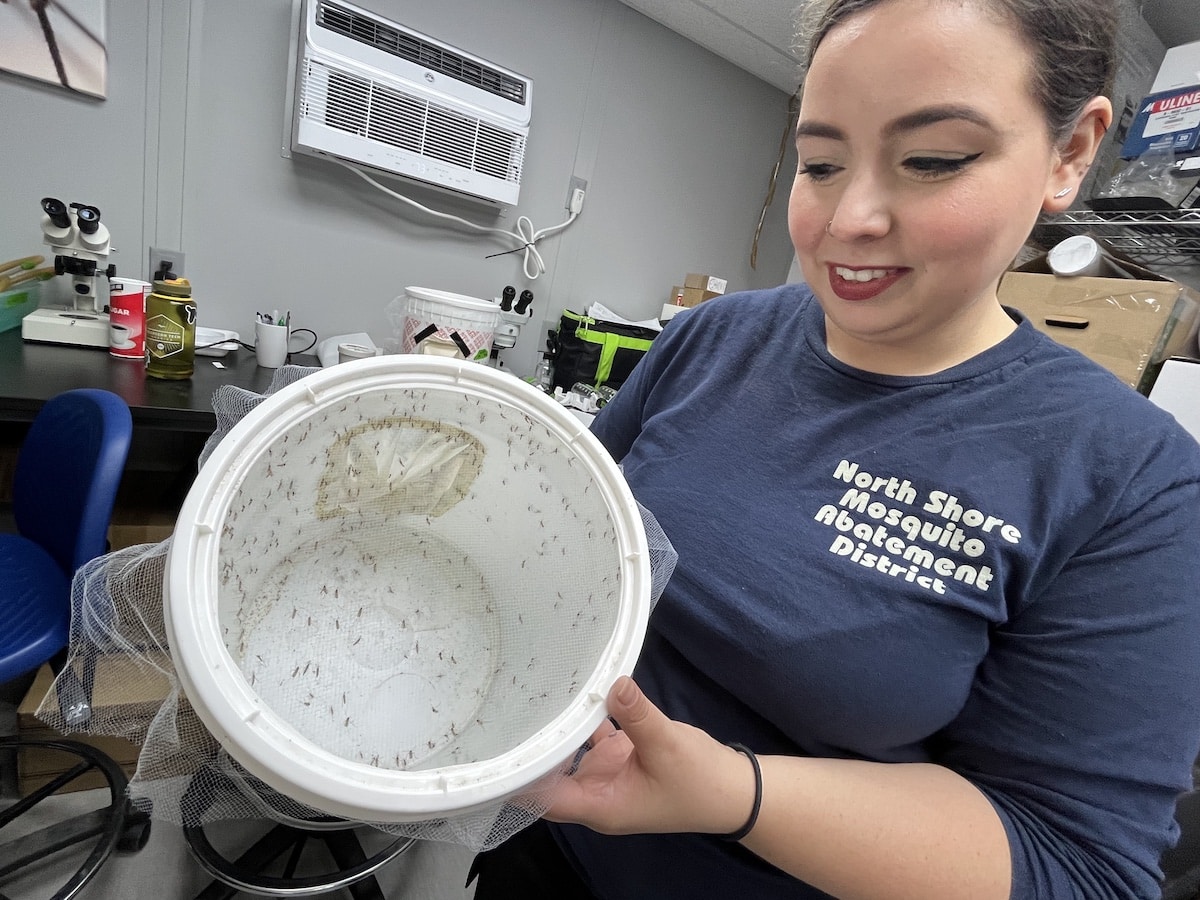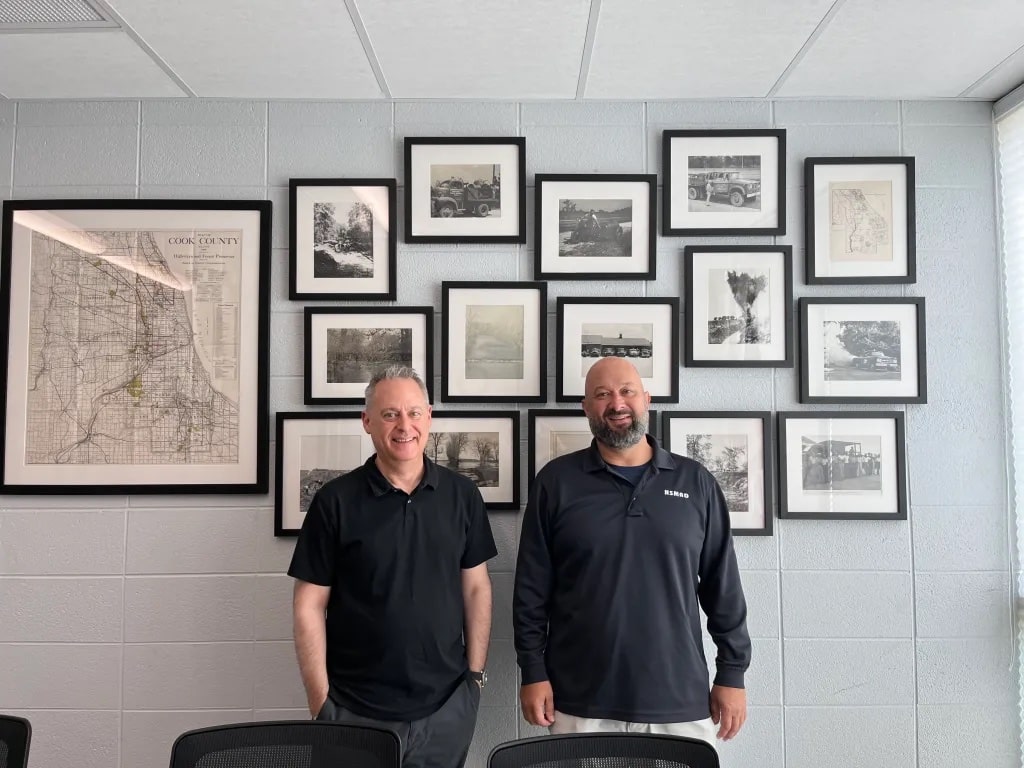
Meet the people protecting you from mosquito diseases
(Editor’s Note: This story was written by Wendi Kromash for a regular column called “Well Being” that was originally published in the Evanston Roundtable, a neighboring independent newsroom. It was shared with The Record as part of an ongoing collaborative effort.)
The primary mission of the North Shore Mosquito Abatement District is succinct and clear-cut: Reduce the risk of disease from mosquito-borne illness. The district tests mosquito samples for West Nile virus and St. Louis encephalitis.
One important tool they use is software called FieldSeeker GIS, a geographical information system. The software is essential with operations (treatments) and surveillance (testing) programs. Data they collect includes service requests received and completed and the location of every catch basin. It notes breeding sites, potential breeding sites and areas for collecting mosquito samples.
Dr. Mark Clifton, the district’s executive director, adjusts resources and strategy based on the data.
“Not every disease is preventable, but we can help to prevent this,” Clifton said, referring to West Nile virus.
The district’s diligence and persistence using data geomapping and killing larvae is delivering results. It reportedly has reduced the district’s share of Illinois’ human West Nile virus cases from around 30% of the state’s total to around 5% of the total on average. So far this year the team has delivered more than 72,000 treatments to curb mosquitoes across the North Shore.
The district serves approximately 330,000 residents in northern Cook County, covering Wilmette, Winnetka, Glencoe, Kenilworth, Northfield, Evanston, Skokie and more.
The district sends weekly reports to those who have signed up for alerts available on the district website.

Getting the job done
Protecting the North Shore from West Nile virus takes intensive work.
On the operations side, seasonal field technicians, primarily college students, perform treatments that prevent mosquito larvae from maturing. They also enter data directly into electronic tablets, noting each address or location visited, action taken, product used and amount of product. These electronic tablets have been a game changer.
“The use of computers out in the field has improved our operations tremendously,” Dave Zazra, communications manager, said.
Back in the lab, there are seasonal lab technicians, usually college students studying biology, entomology or environmental health, who set traps and freeze the mosquitoes collected in order to preserve samples. Freezing allows them to be handled safely. The team counts every mosquito and sorts them by gender and species before testing them for the presence of disease.
Culex pipiens is the mosquito species that spreads diseases in this part of Illinois. The technicians isolate the female Culex pipiens into groups of 50 and test for West Nile virus. Data they collect is published in near real time. This year it is available in a dashboard right on the district’s home page.
In another section of the lab, Kristina Lopez, the district’s research entomologist, focuses on tick surveillance and insecticide resistance in larval and adult mosquitoes. So far 2024 is turning out to be a bad year for dog ticks.
Lopez focused on Culex pipiens while in graduate school at the University of Wisconsin-Madison. After she defended her Ph.D., she celebrated by getting a tattoo of a Culex pipiens on her right arm.
Bookended by first and last frosts
Most of what the district does is preventive. Mosquitoes need water to live. They go through many transformative stages, similar to a caterpillar turning into a butterfly. The field technicians look for the larvae (immature) and pupae (juvenile) of Culex pipiens to prevent them from becoming adults that can kill humans.
This week was the midpoint of the 2024 season and so far the risk of infection is low based on the district’s surveillance and testing.
Clifton said the mosquito season lasts between “the first frost and the last frost.” Maybe a decade ago the mosquito season was pretty much confined to May through September, but now with climate change and longer summers, the season begins in April and lasts through October. Clifton said that in parts of Minnesota, the mosquito season started in February.
According to the Centers for Disease Control, eight out of 10 people infected with West Nile virus do not develop any symptoms. Twenty percent of those infected will develop a fever and perhaps other symptoms, but recover completely; however, about 1 out of every 150 people infected develop a severe illness such as encephalitis or meningitis that affects the central nervous system. Older people are especially vulnerable.
“It’s a terrible way to die,” said Myra Janus, referring to her husband.
Three years ago, Lincoln Janus, a 73-year-old retired attorney and longtime Evanston resident, was bitten by a mosquito carrying West Nile virus. Within weeks, he became paralyzed and placed on a ventilator.
Their story is haunting.
West Nile virus also affects horses, but there is a West Nile vaccine available for horses. The American Association of Equine Practitioners recommends all horses older than 1 year receive this vaccine each year.
Collecting and killing mosquitoes since 1927
The 2023 annual report published by the district quantified the range of their work.
The district employs eight full-time employees and 10 to 14 seasonal employees. Five trustees, appointed by the Cook County Board president, govern the district. The trustees volunteer their time.
One of those trustees, Dr. Marla Isaac is a biology teacher at Evantion Township High School.
“The district is a great organization that helps neighboring communities to prevent the spread of dangerous viruses” she said. “It’s also a tremendous resource for spreading information about how people can protect themselves from these mosquito-borne diseases.”
Funding for the district comes from taxes levied on property located within the boundaries of the member townships. For most local taxpayers, it amounts to less than one-tenth of 1 percent of a homeowner’s total tax bill.
The annual report says “the area covered by the NSMAD consists of 70 square miles of Cook County’s North Shore. This sprawling and diverse area includes more than 900 miles of streets, 60,000 catch basins, 26.9 miles of rivers, 31.8 miles of railroad rights of way, 2.9 miles of ravines, 21.8 miles of bike trails, 17.8 miles of Forest Preserve District trails and approximately 3,500 acres of Forest Preserve District land.”
The district’s secondary mission is to minimize the negative impact mosquitoes have on quality of life. To do this, the district relies on input from the public.
Does your property have standing water? Is your yard so filled with mosquitoes you don’t enjoy being outside? Click here to file a service request online or call (847) 446-9434 to report your mosquito-related issue.
The seasonal workers inspect puddles, old tires, stagnant pools, toys left outside and more.

The type of mosquitoes that are aggressive biters are usually Aedes vexans. They can reproduce three or four times within their short lifespan (usually three to six weeks, although some last a few months) and need a blood meal each time they reproduce. The staff looks for mosquito larvae to interrupt their lifecycle.
Another mosquito they surveil is the Asian tiger mosquito, which could carry viruses like Zika virus, dengue, West Nile virus and dog heartworm.
Birds carry many diseases and act like reservoirs. In suburban Chicago, robins appear to be carriers of West Nile virus. They have the highest viral loads in our area, said Clifton. Mosquitoes bite the birds and contract the virus and are able to spread it to humans.
According to Clifton, the district tries to keep mosquitoes to a manageable level by finding them early and eliminating them. The field technicians are vigilant about treating mosquito-dense areas every 30 or 100 days, depending on the product used. The GIS software alerts them to areas that need to be retreated.
The district is selective where and how it applies treatments to control larval growth. Technicians only apply treatments in water sources where larvae are present, and the treatments only affect mosquitoes. They are nontoxic to people, pets and other organisms.
Another benefit of using the larvicides: reduction of the amount of broad-spectrum pesticides used to kill adult mosquitoes.
Catch basins hold water and material that washes into them. Each municipality cleans out catch basins on a regular schedule, but in the interim they are a perfect breeding environment for mosquitoes, so they get the most treatments.
From mid-October through mid-March the district staff is busy attending professional meetings, evaluating the past year’s results and trends, maintaining equipment and planning for the next year.
In the mosquito world, there is always more to do.
The Record is a nonprofit, nonpartisan community newsroom that relies on reader support to fuel its independent local journalism.
Subscribe to The Record to fund responsible news coverage for your community.
Already a subscriber? You can make a tax-deductible donation at any time.


